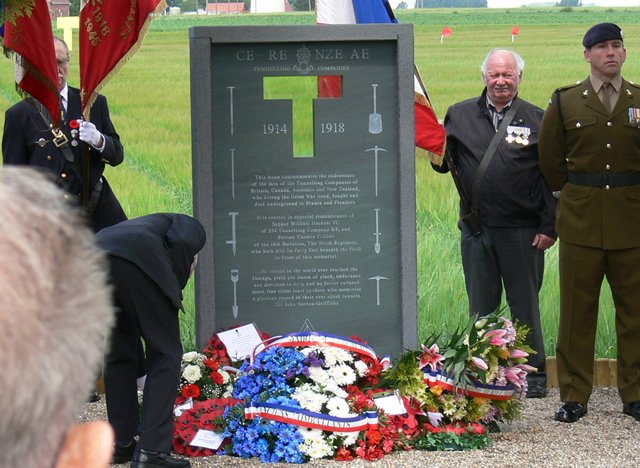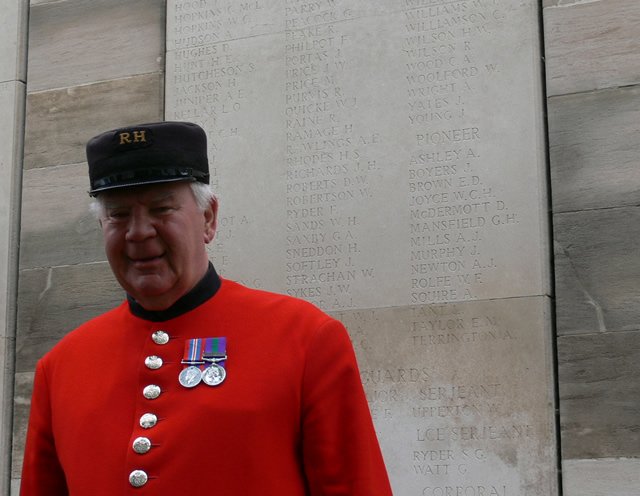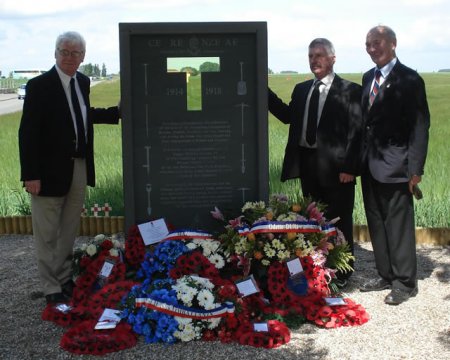The first thing that needed to be decided was where such a Memorial should be located; that was easy. The second stage was to gain permission; that too was not too difficult. The third stage was to raise the funding for the memorial; that was the tricky part, but eventually, as is the way with determined individuals, that too was overcome.
So why were Backroads Touring involved? As one of the companies battlefield guides, it is part of my role to keep abreast of new developments on the Western Front, and I am lucky in that my brother works very closely with Peter. When he told me that the memorial was going to be unveiled, I felt that there may be an opportunity to take interested people from the UK to France for the day to be part of something special. Within a few weeks, I had a number of interested guests, and then, with a stroke of luck, three surviving relatives of one of the men specifically being honoured by the memorial were traced and joined the group.
 Perhaps now is the time to tell you a little about more about the memorial itself. The chosen location was on the edge of the small French village of Givenchy lès la Bassée in French Flanders. Here, in June 1916, the Germans blew a mine against the British lines. This was hardly an unusual occurrence, but on this occasion, there were five men working on a British mine gallery forty feet below the surface of the ground. The concessive impact of the blast collapsed the British gallery, entombing the five tunnellers. After two days, three of the men were brought to the surface, but of the remaining two, one was badly hurt, with crushed ribs. This was Thomas Collins from Swansea. His colleague, an experienced miner from Nottingham, William Hackett chose to stay with him, despite being able to escape through the narrow gap that had been cleared. His last reported words are alleged to have been ‘I am a tunneller, I must look after the others first’. Almost immediately there was another collapse, and the two men found themselves without rescue, buried under forty feet of French soil. William Hackett was posthumously awarded the only Victoria Cross received by a Royal Engineer tunneller during the Great War. The Memorial is shaped to be the same size as the gallery in which William Hackett and Thomas Collins were working, and is positioned so that the yellow T which emblazoned the Tunnellers uniforms and is part of the memorial gives a view to the site of the shaft entrance which served the gallery where the two men still lie.
Perhaps now is the time to tell you a little about more about the memorial itself. The chosen location was on the edge of the small French village of Givenchy lès la Bassée in French Flanders. Here, in June 1916, the Germans blew a mine against the British lines. This was hardly an unusual occurrence, but on this occasion, there were five men working on a British mine gallery forty feet below the surface of the ground. The concessive impact of the blast collapsed the British gallery, entombing the five tunnellers. After two days, three of the men were brought to the surface, but of the remaining two, one was badly hurt, with crushed ribs. This was Thomas Collins from Swansea. His colleague, an experienced miner from Nottingham, William Hackett chose to stay with him, despite being able to escape through the narrow gap that had been cleared. His last reported words are alleged to have been ‘I am a tunneller, I must look after the others first’. Almost immediately there was another collapse, and the two men found themselves without rescue, buried under forty feet of French soil. William Hackett was posthumously awarded the only Victoria Cross received by a Royal Engineer tunneller during the Great War. The Memorial is shaped to be the same size as the gallery in which William Hackett and Thomas Collins were working, and is positioned so that the yellow T which emblazoned the Tunnellers uniforms and is part of the memorial gives a view to the site of the shaft entrance which served the gallery where the two men still lie.
‘I am a tunneller, I must look after the others first'
Thus, early on Saturday 19th June 2010, 12 expectant guests set off from London. We arrived at the village in time to hear the Nottingham Band of the Royal Engineers (Volunteers) before moving into position to listen to the speeches from the local mayor, Peter Barton and Jeremy Banning, who read a moving dairy extract, written by Lieutenant John French, which described the awfulness of the situation that was going on underground at the time. The group then moved, along with about 300 other guests from the UK, France, Canada and New Zealand, to see the ground blessed by the Rev Pat Aldred, before attending the unveiling of the Memorial. Wreaths were laid by the French, British, Canadian and New Zealanders, including three of our guests, Terry Carroll, John Carroll and John Abraham who laid their wreath on behalf of their uncle, Thomas Collins.

We were also fortunate enough to have a reporter from BBC Wales with us, who filmed a sympathetic and well produced piece for the regional news programme. http://news.bbc.co.uk/1/hi/wales/10371047.stm
Later, we were honoured to join the organisers of the ceremony at a private champagne reception and meal in the evening in one of the many restaurants in the centre of Arras.
Our journey was not finished, as on Sunday morning, the group, which also included David Poultney, a Chelsea Pensioner, visited the Loos Memorial to the Missing, where David’s uncle, David Hughes, also a tunneller, was
commemorated, having been killed in October 1915. David laid a small poppy wreath under the panel bearing his name before we headed back to Calais and home.
Backroads Touring is pleased to undertake any special or personal private battlefield tours or visits. Please contact us to discuss your requirements.
